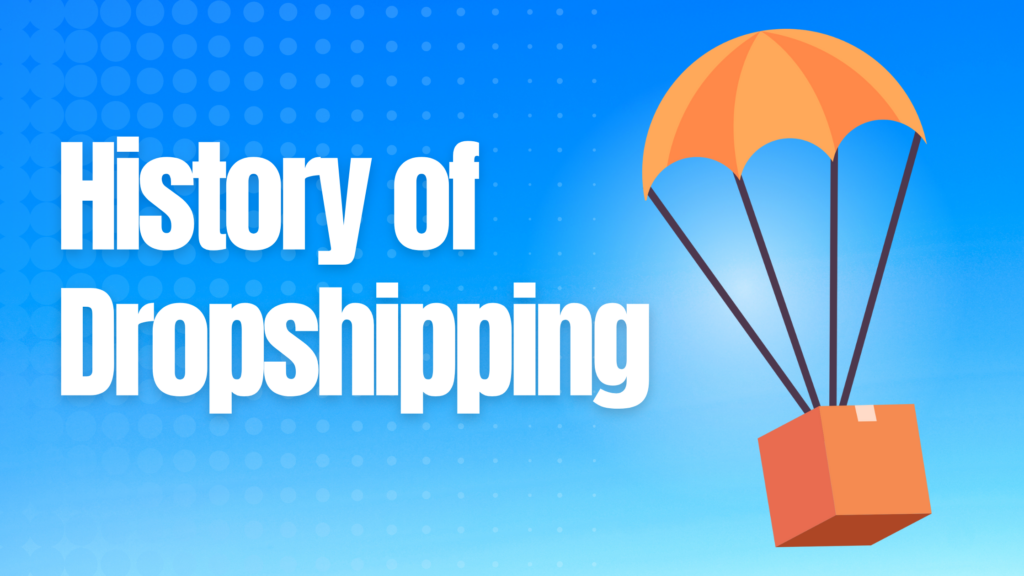History of Dropshipping
Dropshipping has a long history, dating back to ancient times when traders used it to move goods without holding inventory. In recent years, dropshipping has evolved with the rise of ecommerce and technology. Today, it’s a popular business model where retailers sell products without stocking them, relying on suppliers to fulfill orders.
Understanding the history of dropshipping helps us appreciate its journey and how it has become a key player in modern retail. Let’s dive into the dropshipping origins, milestones, and evolution of dropshipping to gain insights into its impact on today’s online marketplace.
The 60s to 90s of Dropshipping
The 60s & 70s
Dropshipping Before the Internet
- Dropshipping began before the internet, in the 60s and 70s, with mail order companies.
- Mail order catalogs advertised products, and customers could order via phone for home delivery.
- JCPenney & Sears used this method extensively, but struggled to keep up with growing demand.
- They developed fulfillment warehouses to speed up shipping, similar to Amazon’s FBA warehouses.
- Exclusive mail order companies like CompuCard saw an opportunity to list warehouse items in their catalogs at a markup.
- When a customer ordered, CompuCard would buy from the warehouse and ship directly to the customer, pioneering the dropshipping model.
The 90s
Dropshipping & the Dot Com Bubble
- With the rise of the internet, mail order companies transitioned to ecommerce stores.
- Early online shopping faced skepticism due to security concerns.
- As attitudes towards online shopping changed, dropshipping gained momentum.
- During the dot com bubble, online stores promised high returns to investors, attracting millions in investments.
- Pets.com was one such store that raised millions but failed to turn a profit, leading to bankruptcy.
- Increased shipping costs from US dropshippers made operations unsustainable, leading to the burst of the dot com bubble in 2001.
Emergence of Modern Dropshipping – The 2000s
In the 2000s, the emergence of ecommerce platforms played a crucial role in shaping the modern dropshipping landscape. These platforms provided online spaces for businesses to sell products directly to consumers without the need for physical storefronts.
With the origins of ecommerce dating back to the 1990s, the 2000s saw a significant expansion and refinement of these platforms. Companies like eBay, Amazon, and Shopify revolutionized the way goods were bought and sold online, offering user-friendly interfaces and robust infrastructure for entrepreneurs to start their own online stores.
As dropshipping evolved alongside the growth of ecommerce, these platforms became essential tools for dropshippers to source products, manage inventory, and fulfill orders. The introduction of ecommerce platforms marked a pivotal moment in the historical overview of dropshipping, paving the way for its widespread adoption and integration into the online retail ecosystem.
Role of Technology in Facilitating Dropshipping.
In the 2000s, modern dropshipping was heavily influenced by advancements in technology, particularly in ecommerce platforms and digital communication. Technology played a crucial role in streamlining dropshipping processes and making them accessible to a wider audience.
Here’s how technology facilitated dropshipping:
Ecommerce Platforms – Platforms like Shopify, WooCommerce, and Magento provide user-friendly interfaces for setting up online stores, making it easier for entrepreneurs to start dropshipping businesses without the need for technical expertise.
Digital Communication – Improved internet connectivity and communication tools enabled seamless communication between retailers, suppliers, and customers, facilitating order management and fulfillment in dropshipping.
Automation Tools – Automation software and tools helped streamline inventory management, order processing, and shipment tracking, reducing manual tasks and enhancing efficiency in dropshipping operations.
Global Reach – Technology enabled dropshippers to access a global marketplace, sourcing products from international suppliers and reaching customers worldwide, expanding the scope and opportunities in dropshipping.
Overall, the role of technology in facilitating dropshipping has been instrumental in shaping its evolution and enabling its widespread adoption in the modern ecommerce landscape, marking a significant milestone in the historical overview of dropshipping and the origins of ecommerce.
Key Events and Milestones that Shaped the Dropshipping Industry.
Dropshipping has a rich history, influenced by various events and milestones that have shaped the industry we know today. Know the key moments that have defined the evolution of dropshipping:
Early Days
- In the absence of the Internet, wholesale fulfillment focused on bulk replenishment, with items shipped in large volumes from manufacturers to retailers.
- Direct-to-consumer (D2C) fulfillment was non-wholesale, with catalogers fulfilling orders from their own inventory in specialized warehouses.
The Rise of Ecommerce
- The emergence of the internet brought about online storefronts, paving the way for ecommerce.
- Established retailers and pure-play retailers alike ventured into ecommerce, experimenting with online sales channels.
Adoption of Dropshipping
- As the number of dropship suppliers grew, traditional retailers began to explore dropshipping as a fulfillment option.
- Retailers realized the benefits of dropshipping, including increased assortment size and reduced inventory risk.
From Experiment to Business Strategy
- Retailers aggressively pursued dropshipping, leading to accelerated sales growth.
- Real-time order status visibility and electronic integration became important for effective dropshipping operations.
Amazon’s Impact
- Amazon revolutionized online retail, raising customer expectations for assortment size and shipping speed.
- Amazon’s extensive warehouse network and logistics expertise set a new standard for ecommerce fulfillment.
Optimization Efforts
- Retailers and dropship suppliers focused on optimizing operations, improving integration capabilities, and enhancing order fulfillment processes.
- The goal was to meet the evolving demands of customers and maintain competitiveness in the online marketplace.
Impact of Ecommerce on Dropshipping
The rise of online retail has significantly impacted dropshipping, shaping its trajectory throughout the dropshipping timeline.
- Increased consumer preference for online shopping has fueled the growth of ecommerce platforms.
- Online retailers seek ways to expand product offerings without the burden of inventory, driving demand for dropshipping services.
- The convenience and accessibility of online shopping have created opportunities for dropshippers to reach a broader audience.
- Ecommerce platforms provide a conducive environment for dropshippers to showcase products and attract customers without the need for physical storefronts.
- The integration of technology and automation in ecommerce operations has streamlined dropshipping processes, enhancing efficiency and scalability.
- As online retail continues to flourish, dropshipping remains a vital component, offering flexibility and cost-effectiveness to businesses navigating the digital marketplace.
Advantages and Challenges of Dropshipping in the Digital Age.
Below mentioned are some advantages and some challenges:
Advantages
- Global Reach – Dropshipping allows businesses to reach customers worldwide, expanding their market reach beyond geographical boundaries.
- Low Overhead Costs – With no need to hold inventory, dropshippers can save on storage and warehousing expenses, reducing overall overhead costs.
- Flexibility – Dropshipping offers flexibility in product selection, allowing businesses to quickly adapt to changing market trends and customer preferences.
- Scalability – As businesses grow, dropshipping allows for easy scalability without the need for significant capital investment in inventory.
Challenges
- Supplier Reliability – Relying on suppliers for order fulfillment can pose challenges, including issues with product quality, shipping delays, and communication breakdowns.
- Competition – The popularity of dropshipping has led to increased competition, making it challenging for new entrants to stand out in the crowded marketplace.
- Customer Service – Maintaining high levels of customer service can be difficult in dropshipping, as businesses may have limited control over product quality, shipping times, and returns.
- Dropshipping Timeline – Understanding the dropshipping timeline is important, as delays in order processing and delivery can impact customer satisfaction and retention.
Role of Globalization in Expanding Dropshipping Opportunities.
Globalization has significantly influenced the expansion of dropshipping opportunities throughout its timeline. As trade barriers have diminished and international commerce has flourished, dropshippers have gained access to a wider range of products and suppliers from around the world. This has diversified product offerings and lowered costs, making dropshipping more accessible to entrepreneurs.
Advancements in technology and logistics have streamlined cross-border transactions, enabling faster shipping and delivery times. As a result, dropshippers can capitalize on the benefits of globalization to source products from diverse markets, expand their customer base, and stay competitive in the global marketplace.
Strategies for Overcoming Challenges and Maximizing Opportunities.
Customer Service Excellence
Prioritize prompt and helpful customer service to address any issues promptly. Offer clear communication and transparency to build trust with customers.
Diversification of Suppliers
Work with multiple suppliers to minimize the risk of disruptions and ensure product availability. Regularly evaluate supplier performance and seek new partnerships to expand product offerings.
Optimized Marketing Strategies
Utilize targeted marketing campaigns to reach specific customer segments and drive sales. Experiment with different marketing channels and tactics to identify what works best for your business.
Efficient Order Management Systems
Implement robust order management systems to streamline processes and reduce errors. Automate order fulfillment wherever possible to improve efficiency and accuracy.
Continuous Learning and Adaptation
Stay updated on industry trends and developments to remain competitive. Be willing to adapt and evolve your strategies based on market changes and customer feedback.
Conclusion
The history of dropshipping reveals its evolution from ancient trading practices to a prominent business model in today’s digital age. Understanding its past helps us navigate its present landscape and anticipate future trends. As dropshipping continues to adapt to changing consumer behaviors and technological advancements, it remains a dynamic and viable option for entrepreneurs looking to enter the world of ecommerce.
By learning from its history, we can leverage the lessons and opportunities provided by dropshipping to build successful online businesses and thrive in the competitive marketplace.




